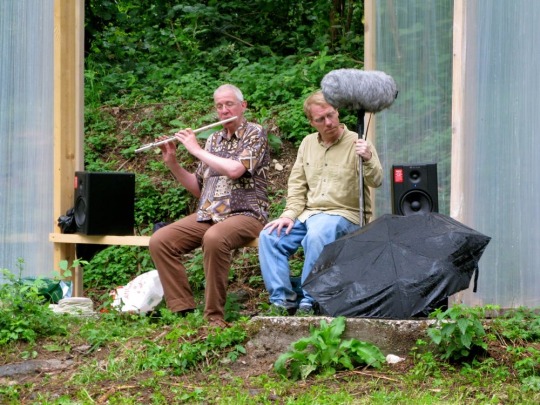#Wandelweiser
Text
Michael Pisaro-Liu — A Room Outdoors (Elsewhere)

Photo by Chiyoko Szlavnics
The premise of A Room Outdoors is simple; bring the outdoors inside. Wandelweiser composer Michael Pisaro-Liu wrote the piece in 2006. It requires a sustaining instrument — a harmonium is prescribed, but a synthesizer or organ will do — a field recording, and 48 minutes of the performers and listeners’ time. According to Pisaro-Liu’s website, the score is seven pages long, but much is left to the performers’ discretion. Depending on what instruments and which field recordings they pick, the sound of the piece could be wildly different, but the intent remains the same.
This CD presents two iterations, both performed by pianist/conductor/curator Guy Vandromme in association with a few other performers. Vandromme is a champion of contemporary works that prioritize aspects of sound over what’s written on a page. Both pieces are part of a project called Timemonochromes… in dialogue with, which sponsors the enactment of performances that invite consideration of the relationship between places and the human-produced sounds that take place within them. A scan of the Timemonochromes Facebook page reveals that not all of these events involve performances of A Room Outdoors, but it’s easy to see how Pisaro-Liu’s score relates would fit into a project that specifically examines such dialogues.
The album comprises two complete performances realized three years apart. The first was done at the Wild Gallery in Brussels in April 2020, and it is visually represented by the empty chair and opaque windows on the front of the album’s sleeve. Packing lots of folks into the space would not have been an option in that time, but humanity feels present nonetheless. It begins with the sounds of distant traffic and braking trams and accumulates further sounds of urban travel. The musicians enter the outdoor sound-space gradually and respectfully. Vandromme is credited with keyboards and Adriaan Severins contributes synthesizer and field recordings, and both of them play long tones that feel like grounding commentary on a wider field of action. The captured traffic carries on, unmindful of the musicians who have taken interest in it. The choice to bring the outdoors into one’s creative space, it seems, can give a body some humbling information about their place in the world.
The second recording took place in June, 2023 at Archaeological Museum of Cremona, Italy. This time, Vandromme sticks to harmonium, and he is accompanied by viola da gamba player Luciana Elizonda, while Fabio Gionfrida wrangles the field recordings. The players’ sounds loom louder in the mix, and their exclusively acoustic origin gives them a rougher grain. But the sounds around them are quite different. Birds, bugs, close-up movement and faraway voices quietly fill the sound field. The louder drones feel imposed upon them, but even though they ride higher in the mix, they ultimately cannot compete with the richness of the nature sounds.
As is typically the case with an Elsewhere production, the recordings are beautifully rendered and the package design resonates consonantly with the sounds. But unlike many other Elsewhere releases, the label website does not have an interview in which the composer or performers explain the work at length. While it’s possible that one will show up down the road, I rather hope that it doesn’t. The merit of this work resides in as much in its ability to get the listener thinking about the sounds’ relationships to each other as it does upon the sounds themselves. It’s up to you if you want to complete this piece with your questions.
Bill Meyer
#Michael Pisaro-Liu#a room outdoors#elsewhere#bill meyer#albumreview#dusted magazine#Guy Vandromme#Fabrio Gionfrida#Adriaan Severins#Luciana Elizondo#wandelweiser#Timemonochromes
1 note
·
View note
Text
Himera esittää: Atte Elias Kantonen, Livia Schweizer, Michael Pisaro-Liu

Lauantai / Saturday 18.5. 19:00 (ovet/doors 18:30)
Tehdasteatterin Jokistudio
Liput 8/5€
Ohjelma / Program:
Atte Elias Kantonen - solo electronics
Livia Schweizer - within (1) for solo flute by Michael Pisaro-Liu
Atte Elias Kantonen
Atte Elias Kantonen (b. 1992) is a Helsinki, Finland -based sound designer, sonic artist and composer working mostly in the fields of experimental music and contemporary performing arts.
The aim of Kantonen’s sounding discipline is to sculpt sound into delicate forms that are constantly affected by a kind of mutant nature encompassing a variety of tones – ranging from glassy to organismic, earthly to ethereal. Kantonen’s composing process consists of creating sonic events that play with the idea of form, space and time as having incessant elasticity. When it comes to designing sound for a performance, Kantonen incorporates spatial and electro-mechanical layers to his designs, ranging from unconventional speaker arrangements to sounding kinetic sculptures.
Kantonen has a conceptual side project “ant spa ·)((“, which currently consists of a monthly experimental music radio show on IDA radio and experimental music and sound performance event edition “bugbath”. His work has been supported by Arts Promotion Centre Finland and Music Foundation Finland and for the year 2024 by the Kone foundation.
Livia Schweizer
Livia Schweizer (b.1994) is a flutist, improvisor, educator and artistic researcher based in Helsinki. She is known for her interest in improvisation and non-conventional music notation as a tool of bringing together creative souls from different backgrounds, ages and cultures.
Livia grew up in Tuscany and has lived in Finland since 2014. Since moving to Helsinki Livia has been performing solo and in chamber ensembles for festivals such as the Flow Festival, Helsingin Juhlaviikot, the UNM Festival, Tulkinnanvaraista, Luosto Soi, Uuden Musiikin Lokakuu, Jauna Muzika (Lithuania), SoundScapes (Germany), Hiljaisuus Festival and Musica Nova. Her passion towards contemporary and experimental music brought her to be part in several projects with the NYKY-ensemble, Avanti!, Korvat Auki, the UMUU-ensemble, Eloa ry and Tampering, and in 2021 she became member of the Earth Ears Ensemble, an ensemble focused on contemporary music from lesser heard voices.
Michael Pisaro-Liu
Michael Pisaro-Liu (born, Michael Pisaro, 1961 in Buffalo, New York) is a guitarist and composer and a long-time member of the Wandelweiser collective. While, like other members of Wandelweiser, Pisaro-Liu is known for pieces of long duration with periods of silence, in the past fifteen years his work has branched out in many directions, including work with field recording, electronics, improvisation and ensembles of very different kinds of instrumental constitution.
Pisaro-Liu has a long-standing collaboration with percussionist Greg Stuart, with over thirty collaborations (pieces and recordings) to date, including their 3-disc set, Continuum Unbound from 2014 and Umbra & Penumbra for amplified percussion and orchestra premiered by the La Jolla Symphony in February, 2020. Pisaro-Liu also has recurring (intermittent) duos with Christian Wolff, Keith Rowe, Taku Sugimoto, Antoine Beuger, Graham Lambkin, Toshiya Tsunoda and Reinier van Houdt. There are several recent compositions for orchestras of various kinds and constitutions – including commissioned work for the BBC Scottish Symphony, INSUB MetaOrchestra and the Grand Orchestre de Muzzix. Much of his current work takes the form of mixed-media assemblages, in collaboration with filmmaker/artist/writer Cherlyn Hsing-Hsin Pisaro-Liu.
Recordings of his music have been released by Edition Wandelweiser Records, erstwhile records, New World Records, elsewhere music, Hubro, Potlatch, another timbre, meena/ftarri, Senufo Editions, Intonema, winds measure, HEM Berlin and on Pisaro's own imprint, Gravity Wave. His work is regularly performed throughout the US, Europe, South America and Southeast Asia.
Pisaro-Liu is the Director of Composition and Experimental Music the California Institute of the Arts.
within (1)
for solo flute
within is a series of six pieces for solo instrument, that were written for the 3-year project at the Zionskirche in Berlin, organized by Wandelweiser members, Carlo Inderhees and Christoph Nicolaus from 1997 to 1999. (3 Jahre - 156 Musikalische Ereignisse - eine Skulptur). It featured the premiere of a 10 minute piece every Tuesday at 7:30pm in the choir balcony of the church. (There were eventually about 30 composers involved in the project.) “within (1)” for solo flute, was the first piece performed on the series, in January, 1997. Eventually all six of the 10-minute sections were played the church.
The piece is built upon the individual colors of single flute tones. A tone is played once or repeated a number of times before moving to the next. Because of the sustained impression of the single tone, it functions like a “plateau”, whose level changes when the next note occurs (always following a silence). It is a slow moving, glacial, melodic landscape.
0 notes
Text
Experimentik #70 / January 17. 2024 / Lucio Capece / Claudia Risch + Francis Heery + Jung-Jae Kim
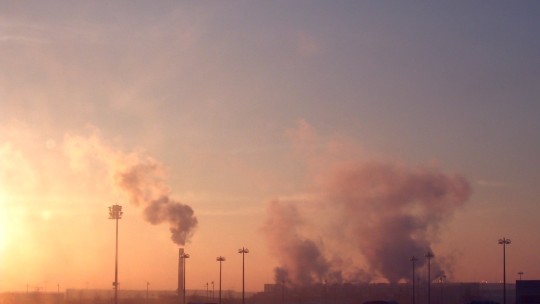
January 17. 2024 / 20:30- (doors 20:00)
Solo:
Lucio Capece - 8 voices Sampler Isla 2400, recorded cello and bass clarinet, sine-sawtooth tones and pulses
---------
Trio:
Claudia Risch - bass clarinet
Francis Heery - electronics
Jung-Jae Kim - saxophone
FB event: https://fb.me/e/3Ywj3sQuL
----------------
Lucio Capece
Argentinian musician based in Europe since 2002, specifically in Berlin since 2004. Since 2010 he dedicates to offer works focused in the Perception experience, that he performs mainly in solo and in the context of occasional collaborations based in the same interest. He composes his own pieces that may include improvisation and different ways of writing. He uses tools like Flying Speakers hanging from Helium Balloons moved by propellers, Speakers as Pendulums, Analog synthesiser, Sine Waves and Noise Generators, Drum Machines, Ultra- Violet Lights, Sensors as much as the instruments that he has played for 25 years: Bass Clarinet and Soprano and Slide Saxophone. Beyond instrumentation and tools, the main intention is to focus in the physical-social-spatial human experience. Between the late 90 ́s and 2010 he offered music in the context of Electro Acoustic Improvisation, focused in quietness, attentive listening and granular material. Capece has been very active in the Reductionist Improvised Music scene in Berlin, and in the radical minimal scene related with the collective Wandelweiser collaborating mainly as member of the collective Konzert Minimal (2008- 2018) and, since 2006 with Radu Malfatti. In a parallel way Capece developed a 10 years collaboration with legendary Finnish musician Mika Vainio from Pan Sonic, working and releasing radical abstract and beats oriented music as a duo and two different quartets. Capece has performed his own sound interventions in spaces like Kraftwerk Berlin ( The Long Now - Maerz Musik), Hau Berlin (CTM festival), The Cathedral of Bern (Zoom In Festival) The Mambo Museum in Bologna (Live Arts week ),the German Pavilion built by Mies Van der Rohe in Barcelona (Sonar +D Festival), the Halle d ‘Expositions built by Alexandre Gustave Eiffel in Evreux, France (ĹÁtelie series) the Bauhaus Archive in Berlin (directing a piece in which together with musicians Axel Dörner and Robin Hayward played a piece with the kinetic sculpture called “Licht-Raum Modulator” built by Lászlò Moholy-Nagy) , and the Colón Theatre in Buenos Aires where he offered an interactive installation for children. Since 2020 he plays mainly in the context of small Ensembles where he composes the music, or collaborates with others performers-composers like Rahma Quartet, From Scratch New Discantus Quintet, Lost Jockey and Phase to Phase. His goal in this context is to re consider Music making in a Phenomenological way, re- searching in the basic elements that make Music be. He offers currently a Sampler solo set based in a personal research in Just Intonation Ratios, folding and unfolding sounds from Pitch to Pulse and vice versa. He has performed as a musician in recognised experimental music festivals and venues in Europe, USA, Japan, Mexico and Argentina. He has released around 35 Cds and Lps, including 9 solo releases, in labels like Mego Editions, B-Boim (Austria), Pan (Germany), Ftarri (Japan) Another Timbre, Entr ́acte ( UK), Potlatch, (France), Erstwhile Intonema (Russia), etc.
photo © Susi Maresca

----------------
Claudia Risch has developed special playing techniques on the Bassclarinet, which is acoustic of it´s nature and works without additive external resorces. She focusses on the extended sound-material of her instruments like micro-intervals, multi-phonics, sound of breath. Within this variety of elaborated technical possibilities Risch combines, applies and modifies her material to create a refined, nuanced and multilayerd sound. The co-operation with composers (e.g. Thomas Gerwin, Francis Heery), electronics and dancers is an important component in her work.
https://www.instagram.com/claudiarisch07/
photo © Matthias Förster

---------------
Francis Heery (b.1980) is a composer and sound artist. His music is inspired by science-fiction, occultism and animal aesthetics. He is an accomplished improvisor and performs with a setup integrating Max/MSP with acoustic instruments and modular synths. He specializes in long-form, site-specific performances in public spaces. His instrumental works have been performed by the RTE Symphony Orchestra, the Crash Ensemble, the Quiet Music Ensemble, the Talujon Percussion Ensemble and by soloists including Carin Levine, Pascal Galois and Izumi Kimura. He has received funding awards from the Arts Council of Ireland as well as commissions from Galway County and City Councils, the Music Current Festival, the Berlin Natural History Museum, and the Berlin International Sound Art Festival. He produces experimental electronica under the name The Cube of Unknowing, with albums released on Fort Evil Fruit and Eiderdown Records.

----------------
Jung-Jae Kim is a South Korean saxophonist, composer, and improviser based in Berlin free/avant-garde & experimental music scene. He pushes the boundaries of sonic aesthetics and sound definitions, taking a transdisciplinary approach to explore new possibilities and delve into human senses and communication through free improvisation.
photo © Morvarid K

------------------
Experimentik 2024 is supported by inm

0 notes
Text
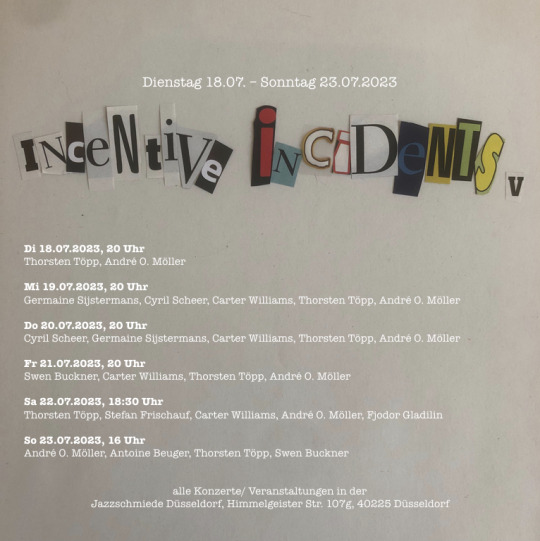
Am Freitag, 21.07.2023 um 20 Uhr spiele ich in der Jazzschmiede Düsseldorf, Himmelgeister Strasse 107g, 40225 Düsseldorf meine Klangstudie "Grauer Amber" für E-Gitarre, FX und Elektronik -- im Rahmen der Incentive Incidents V Woche von André O. Möller.
Danach spielen noch
das New Trio for viola d’amore and two guitars ein neues Stück von Thorsten Töpp,
sowie Carter Williams (solo) Deep space (for viola d’amore and live-electronics).
Der Eintritt erfolgt auf freiwilliger Spendenbasis. Ich empfehle 10er mitzunehmen und bei der Gelegenheit vor Ort kostengünstig Wandelweiser-CDs zu erwerben. Außerdem empfehle ich einen Blick auf das gesamte Programm der Incentive Incidents V Woche hier im PDF https://mcusercontent.com/8643f2eec6b029d097655baf3/files/1bfcd6d8-e116-d312-83ba-61239cffebcd/incentive_incidents_2023_programm.pdf
oder aber auf der Website von Wandelweiser https://www.wandelweiser.de/_concert-series/klangraum.html
Dort findet ihr auch Hinweise zu den Klangraum-Wochen kuratiert von Antoine Beuger, die bereits am Dienstag begonnen haben.
Klangraum/ Incentive Incidents sind eine prima Gelegenheit, sich mit Neuer Musik zu beschäftigen und vielleicht der letzte Geheimtip in Düsseldorf, der es aber jetzt nicht mehr ist.
0 notes
Photo


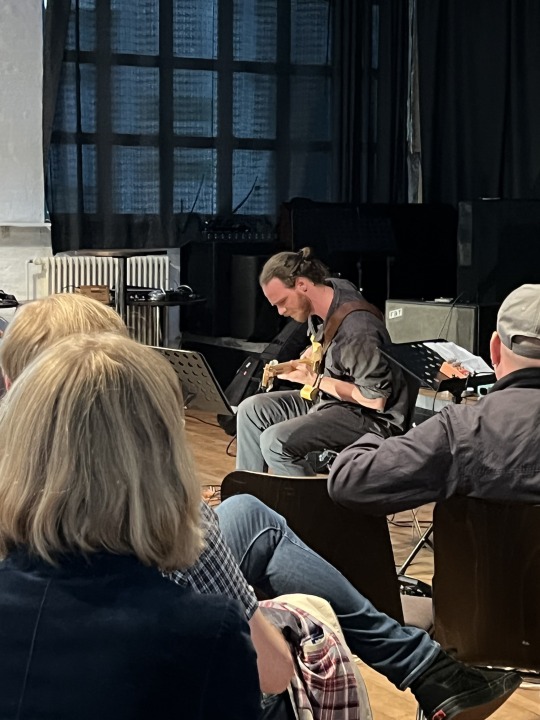

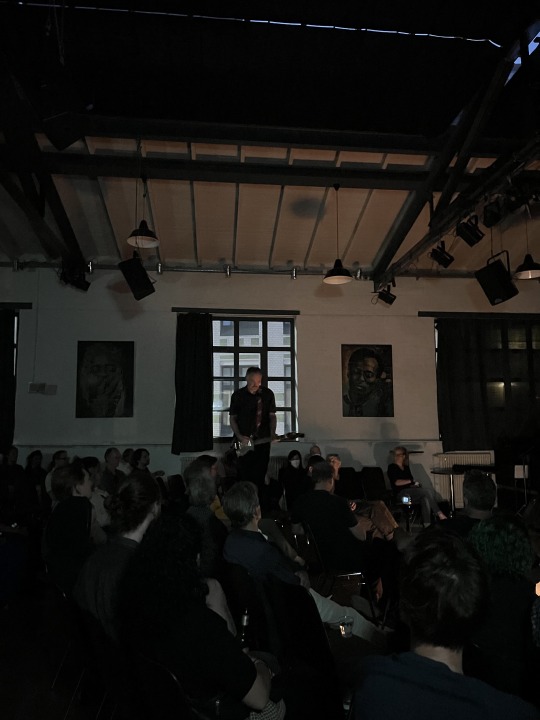
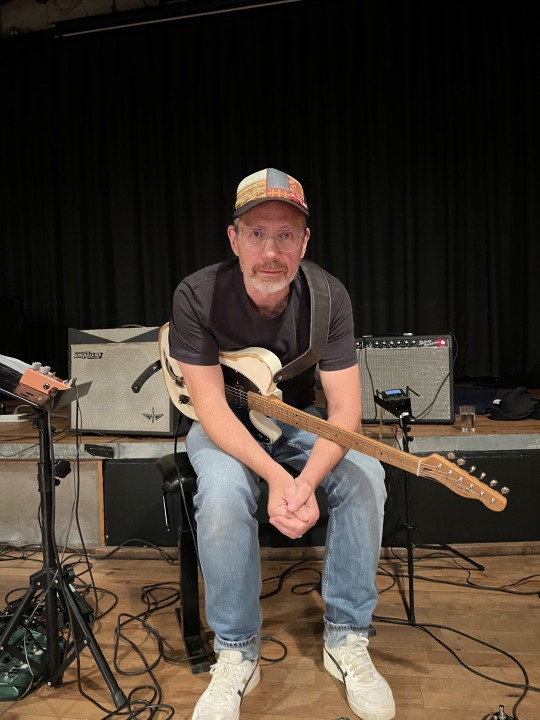




c!ang #40
5 x 15 Minuten E-Gitarre, solo
mit
Milan Heinrich (Köln)
Christian Jendreiko (Ddorf)
Martin Kircher (Mgladbach)
Alex Gunia (Köln)
Shunsuke Oshio (Ddorf)
Samstag, 15. Juli 2022
Einlass 20 Uhr, Beginn 21:00 Uhr
zu Gast bei
incentive incidents iv
kuratiert von André O. Möller
Edition Wandelweiser Records, Klangraum 2022
Jazz-Schmiede
Himmelgeister Straße 107g
40225 Düsseldorf-Bilk
Eintritt frei, nur für geladene Gäste
c!ang ist eine private Veranstaltung
+++ abweichender Veranstaltungsort +++ Pandemisch bedingt: 3G (geimpft, genesen oder tagesaktuell getestet) & bitte Maske mitbringen +++
clang-row.wixsite.com/clang
0 notes
Audio
3 notes
·
View notes
Audio
(cafeOTO)
2 notes
·
View notes
Text
“When one walks through the city listening to Wandelweiser, it’s not that the music soundtracks the city, it’s the other way around. The city enters the music. There is no mediation because there are not two distinct states to mediate between. Or, seen another way, the question of mediation becomes absolutely primary; as in Pisaro’s field recordings or in the occasional sounds that Wereder’s date pieces introduce into a space, the content of the musical sound is almost beside the point.
What we primarily here is the otherness of a (musical) sound in relation to our (nonmusical) surroundings. Like a veil over our eyes, it is not the particular qualities of the veil that we see (the pattern or density of the weave, the thickness of the threads), but the general state of “veil-ness” that it casts on what we see through it.” - Tim Rutherford-Johnson in Music After the Fall (2017)
“With recording, sound is stored for use. How do you use a recording like Stones [Christian Wolff]? Do you just listen to it like anything else (perfectly possible in this case) or do you find ways of listening to it that suit the recording in other ways: say playing it all day at low volume (so that it can be forgotten, except for those very few moments when a sound rises to the surface, reminding you it’s still there). Or play it so loud that you hear everything.
In other words, the recording can be viewed as open, something like an instrument - a particular instrument that makes a limited set of sounds that can nonetheless have a variable relationship in the environment in which they are played” - Michael Pisaro from Wandelweiser, appearing in Music After the Fall
#michael pisaro#wandelweiser#contemporary composition#music after the fall#tim rutherford-johnson#2017#idea#field recording
2 notes
·
View notes
Text
Sergio Merce, "En lugar de pensar" (CD Review"
Sergio Merce, “En lugar de pensar” (CD Review”
Sergio Merce
En lugar de pensar (Instead of thinking)
Wandelweiser CD
“The name of the album is about this feeling that I have. I believe that playing music is a non-cerebral thought form; thought in the sense of being a channel to see, to reveal, a channel that opens through intuition, observation and attention but not through…

View On WordPress
0 notes
Photo

Cy Twombly - Fifty Days at Iliam. Shades of Eternal Night [1978]
“One of the things that’s so powerful about this mythological reference is that you know you’re dealing with history, but you don’t sense distance.”
“...it seems to me like they’re painted to represent more dimensions than the three or four that we live in. You very often in Twombly get square upon square or squares scrawled at odd angles to each other, or you get a famous motif of his, a kind of continuing line that circles and circles and circles. If you look at these early-ish [works], these paintings from the ’50s, I’d seen them a lot of times, but it started to occur to me that they’re not flat. Of course, they’re represented in the two or three dimensions of the canvas, but I somehow stopped seeing that way and started seeing them as kind of impossible geometry.”
“I started to see that these two things, this weird ultra-dimensionality and this preoccupation of time, are actually versions of the same thing, or at least they cooperate together.“
Michael Pisaro [RBMA interview]
2 notes
·
View notes
Text
Germaine Sijstermans — Betula (Elsewhere)

Photo by Ana Lemnaru
Betula by Germaine Sijstermans
The cover of Germaine Sijstermans’ Betula includes an image of small rocks suspended from a ceiling by taut cords. Sijstermans is an installation artist as well as a composer and clarinetist, and the photograph is a close-up from one of her pieces. If you go to her website, you’ll see that the lines and things she strings across rooms serve mostly to make you aware of the dimensions and contours of the spaces they bisect.
One could say the same thing about her music. The album opens with slowly arcing pitches played by violist Johnny Chang, which shiver in close proximity to long tones played on flute by Antoine Beuger and clarinet by the composer. Each draw of the bow or woodwind-magnified breath could be a line in one of Sijstermans’ installations. Their sounds draw attention away from the sounds themselves, and invite an awareness of what surrounds them. The space doesn’t seem empty; rather, it is suffused with gentle vibration, like autumn leaves bouncing orange back at the sun. Given that Betula translates as Birch, this is probably a very intentional result.
The opening piece, “a song” (2018), last just 8.11, which on this double CD makes it a small plate. The next piece, “Jasminum” (2019), is more of a main course. Over the course of nearly 31 minutes, the entire ensemble, which also includes trombonist Rishin Singh, guitarist Fredrik Rasten, and accordionist Leo Svirsky, makes itself felt, but only occasionally all at once. Often, a quietly plucked harmonic or held tone will intensify another, more loudly played sound, functioning like one of those suspended stones. At other points, one seems to flower out of another, like the advancing branches of ivy climbing up a wall.
This music is played with such quiet assurance that the developmental process merits acknowledgement. Sijstermans developed the album’s contents over the course of a residency at Intro In Situ, in Maastricht, Netherlands. The five musicians who accompany her played the pieces during work-in-progress presentations, cultivating a relationship to each other and to the music as organically as ecosystem.
Bill Meyer
#Germaine Sijstermans#betula#elsewhere#bill meyer#albumreview#dusted magazine#wandelweiser#contemporary classical music
1 note
·
View note
Photo
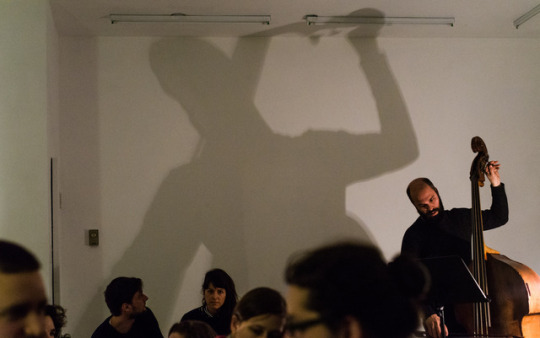
Common place no. 1
#music#simonlabbé#bass#doublebass#contrebasse#montréal#art#gallery#espaceprojet#quiet#wandelweiser#photography#live
3 notes
·
View notes
Text
Himera esittää: John McCowen

Nykytaidetila Kutomo
la 27.5.2023
Klo. 18:00
10/5€
Himeran toukokuisessa konsertissa Nykytaidetila Kutomolla John McCowen esittää soolotöitään kontrabassoklarinetille vuonna 2022 ilmestyneeltä levyltään Models of Duration. Keskiössä ovat soittimen mahdollisuudet polyfonian tuottajana. Käsittelemällä tarkasti klarinetin äänten kirjoa syntyy lieriön luonnollisten yläsävelten kieli. Musiikissa on monia itsekseen liikkuvia horisontteja, jotka yksi akustinen äänilähde saa aikaan. Mikrofonien tarkan sijoittelun avulla kuuntelija tuodaan soittimen sisään, ääntä ei tuoteta elektronisesti.
John McCowen on säveltäjä ja klarinetisti, joka keskittyy laajentamaan kontrabassoklarinetin ja muiden soitinten mahdollisuuksia. The New Yorker kuvaili hänen työtään äänen tutkimiseksi mikroskoopin avulla. McCowenin soittotapa syleilee droneja, erotusääniä ja yläsäveliä, hän puristaa yhdestä akustisesta äänilähteestä ulos sen sävellyksellisiä mahdollisuuksia. McCowen asuu tällä hetkellä Reykjavikissa, missä hän opettaa improvisaatiota Islannin taideyliopistolla.
ENG
In Himera’s May concert at Contemporary Art Space Kutomo John McCowen performs works for solo contrabass clarinet from his 2022 album Models of Duration. These works showcase the contrabass clarinet as a polyphonic instrument. By finessing the instrument’s sonic spectrum, a language based in the natural harmonics of a cylinder is developed. Put simply, the music features multiple, independent moving lines from one acoustic sound source. With specific microphone placement, the listener is brought inside the instrument. There are no electronically generated sounds. This is acoustic music.
John McCowen is a composer and clarinetist focused on extending the possibilities of the contrabass clarinet and other instruments. His work has been described by The New Yorker as the sonic equivalent of microscopic life viewed on a slide. McCowen’s multiphonic approach embraces drones, difference tones, and beating harmonics as a means to extrude the compositional potential within a single, acoustic sound source. Documents of this practice have been released by International Anthem, Edition Wandelweiser, Astral Spirits/Monofonus Press, Dinzu Artefacts, Cairn Desk, SUPERPANG, and others. He currently resides in Reykjavík, Iceland where he teaches improvisation at the Iceland University of the Arts.
johnmccowen.com
Kuva / photo: Viðar Logi
0 notes
Text
[12.04-02.06.2019] Wszyscy spotkamy się w tym samym miejscu

12 kwietnia 2019 – 2 czerwca 2019
BWA Wrocław Główny
ul. Józefa Piłsudskiego 105, 50-085 Wrocław
artyści: Wojciech Bruszewski, Sebastian Buczek, Matěj Frank, Grupa Budapeszt, Sarah Hennies, Łukasz Jastrubczak, Rolf Julius, Brandon LaBelle, Karolina Pietrzyk, Gilbert Schneider, Kama Sokolnicka, Wandelweiser Komponisten Ensemble, Ryszard Waśko, Tobias Wenig, Christian Wolff, Zorka Wollny, Anna Zaradny, Artur Żmijewski
rezydencje choreograficzne: Anna Nowicka, Aleksandra Osowicz, Magdalena Ptasznik, Agata Siniarska
kuratorzy: Paweł Szroniak, Karolina Wycisk, Magdalena Zamorska
Wystawa Wszyscy spotkamy się w tym samym miejscu to połączenie dwóch praktyk kuratorskich odwołujących się do zagadnień dźwięku i ruchu w kontekście sztuki współczesnej. Pierwsza – przygotowana przez Pawła Szroniaka i związana z tematem percepcji dźwięku – ma wyznaczać rodzaj konceptualnej ramy i zorganizowanego otoczenia. Druga – za którą odpowiadają Magdalena Zamorska i Karolina Wycisk – będzie skupiona na nowym spojrzeniu na zagadnienia współczesnej choreografii i zagości w przestrzeni wystawy, reinterpretując poszczególne wątki w tygodniowym rytmie, odmierzanym wizytami czterech artystek związanych ze sceną ruchu.
U podstaw ekspozycji opracowanej przez Pawła Szroniaka w galerii BWA Wrocław Główny leży próba zaprezentowania artystów, których twórczość pozwala na dokonanie znaczących przewartościowań w obszarze kultury audialnej. Punktem wyjścia do wystawy Wszyscy spotkamy się w tym samym miejscu jest tu tradycja eksperymentu muzycznego, wytyczona w połowie XX wieku przez amerykańskiego kompozytora Johna Cage’a. W nawiązaniu do niej zaproponowany zostanie sposób definiowania sound artu jako pola praktyk, które umożliwiają rozszerzenie pojęć dźwięku i słyszenia. Kurator wybrał artystów i prace, które łącząc się na tej wystawie, tworzą rodzaj alternatywnego kanonu. Wśród zaproszonych twórców są m.in. Rolf Julius, Wojciech Bruszewski, Ryszard Waśko, Anna Zaradny, Sarah Hennies, Brandon LaBelle, Artur Żmijewski czy Kama Sokolnicka.
“Poruszymy wiele zagadnień dotyczących ontologii i epistemologii dźwięku” – opowiada kurator – “zwłaszcza te związane z wyobrażeniami audialnymi, pamięcią dźwiękową, percepcją dźwięku oraz różnymi trybami uważności”. Będzie to wyzwanie dla widzów, by wyjść poza swoje dźwiękowe przyzwyczajenia i w głęboki sposób doświadczyć wystawy. Obiekty, instalacje i inne formy komunikatów audiowizualnych zostaną poddane reinterpretacji za sprawą działań performatywnych, otwierając się na zagadnienia związane z ruchem i gestem. Obie płaszczyzny znaczeniowe przetną się w czułym punkcie, jakim jest ciało widza.
Ważnym elementem wystawy są również tygodniowe mini-rezydencje czterech artystek (Magdalena Ptasznik, Anna Nowicka, Aleksandra Osowicz i Agata Siniarska) związanych z choreografią, ruchem, tańcem. Kuratorki tej części projektu, Karolina Wycisk i Magdalena Zamorska, zdecydowały, że łączącym je dodatkowo tematem będą dyfuzje, czyli obszary wspólne między tym, co konkretne i materialne, a tym, co przemieszcza się i przeistacza. Artystki mają badać i tworzyć lokalnie uwarunkowane choreografie, wykorzystując jako budulec zastane materie (w tym te niewidzialne), układy sił i obiektów oraz przepływy i relacje. Ich choreografie zainfekują odbiór fizycznej warstwy ekspozycji i w trakcie otwartych dla publiczności działań, artystki będą także eksperymentować z ucieleśnianiem pojęć ekologicznych i biochemicznych.
________________
Wydarzenia towarzyszące:
12.04.2019, godz. 19.00
Wernisaż i koncert Sebastiana Buczka
24.04.2019, godz. 18.00–20.00
Composing Listening – warsztaty performatywne Billa Dietza
27.04.2019, godz. 16.00–18.00
Tania imitacja albo ćwiczenia z nagrywania ciszy – warsztaty
Więcej informacji o programie (w tym szczegóły dotyczące rezydencji choreograficznych): http://bwa.wroc.pl/events/wszyscy-spotkamy-sie-w-tym-samym-miejscu/
________________
FB: https://www.facebook.com/events/642954482813659
________________
Plakat: Karolina Pietrzyk, Gilbert Schneider, Tobias Wenig
#wojciech bruszewski#sebastian buczek#matěj frank#grupa budapeszt#sarah hennies#łukasz jastrubczak#rolf julius#brandon labelle#Karolina Pietrzyk#gilbert schneider#kama sokolnicka#wandelweiser komponisten ensemble#antoine beuger#michael pisaro#ryszard waśko#tobias wenig#christian wolff#zorka wollny#anna zaradny#artur żmijewski#bill dietz#rozkurz#bwa wroclaw#karolina wycisk#magdalena zamorska
2 notes
·
View notes
